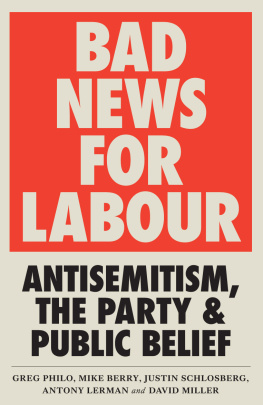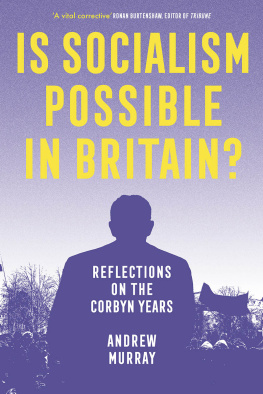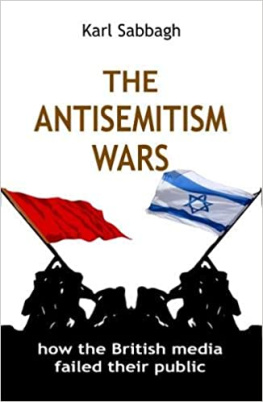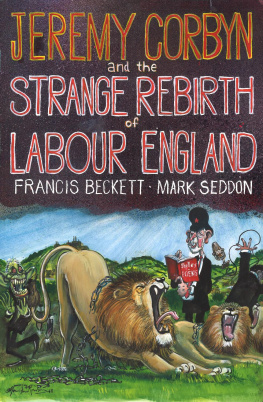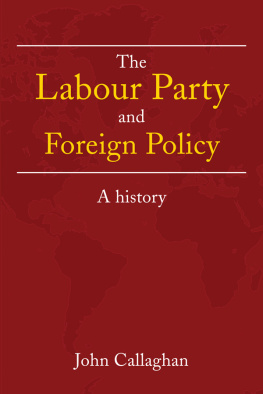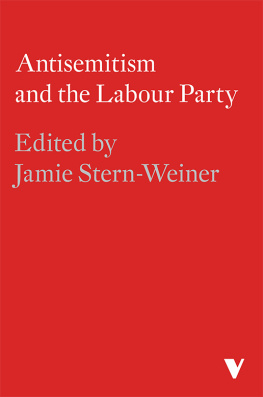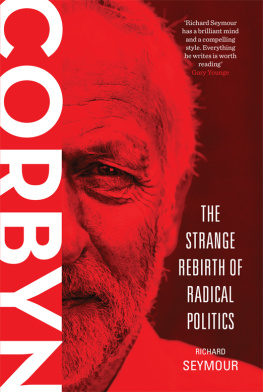Contents
- 1. Believe It or Not
Greg Philo and Mike Berry - 2. Divisions and Competing Accounts
Greg Philo and Mike Berry - 3. What Could Have Been Done and Why It Wasnt, and Will It End?
Greg Philo and Mike Berry - 4. Media Coverage of the IHRA Definition and Its Adoption by the Labour Party
Justin Schlosberg - 5. Weapons in the Labour Antisemitism Wars? The IHRA Working Definition and the Accusation of Institutional Antisemitism
Antony Lerman - 6. A State of Israel or The State of Israel: The Politics of the IHRA Definition
David Miller - Appendix: Timeline of Events
Mike Berry and Greg Philo
Guide
Bad News for Labour
The essays in this book provide evidence and arguments that are deeply troubling for all concerned, and demand careful attention.
Peter Golding, Emeritus Professor, Northumbria University
At last! Here is a book that rigorously examines the facts behind the allegations of antisemitism in the Labour Party. The reality is more shocking, and more surprising, than the headlines in the press would have you believe. Here is the evidence read it. Then learn the lessons suggested here.
Ken Loach
What the careful research reported in this book reveals is a successful disinformation campaign. Anyone who cares for facts needs to read it.
Colin Leys, Honorary Professor at Goldsmiths University of London
Reading this timely book convinces me that the media campaign against antisemitism in the Labour Party is similar to the media onslaught on the loony left in the 1980s. Both campaigns connected to some disturbing truths: and both inflated and weaponised these truths for political purposes.
Professor James Curran, Goldsmiths, University of London
This compelling, thoughtful text is essential reading for everyone on the left wanting to confront antisemitism. It provides a benchmark for future research and strategy when tackling this explosive issue of our time.
Lynne Segal, Birkbeck University of London
Bad News for Labour
Antisemitism, the Party and Public Belief
Greg Philo, Mike Berry, Justin Schlosberg, Antony Lerman and David Miller

First published 2019 by Pluto Press
345 Archway Road, London N6 5AA
www.plutobooks.com
Copyright Greg Philo, Mike Berry, Justin Schlosberg, Antony Lerman and David Miller 2019
The right of Greg Philo, Mike Berry, Justin Schlosberg, Antony Lerman and David Miller to be identified as the authors of this work has been asserted by them in accordance with the Copyright, Designs and Patents Act 1988.
British Library Cataloguing in Publication Data
A catalogue record for this book is available from the British Library
ISBN 978 0 7453 4065 4 Hardback
ISBN 978 0 7453 4066 1 Paperback
ISBN 978 1 7868 0571 3 PDF eBook
ISBN 978 1 7868 0573 7 Kindle eBook
ISBN 978 1 7868 0572 0 EPUB eBook
This book is printed on paper suitable for recycling and made from fully managed and sustained forest sources. Logging, pulping and manufacturing processes are expected to conform to the environmental standards of the country of origin.
Typeset by Stanford DTP Services, Northampton, England
Simultaneously printed in the United Kingdom and United States of America
Contents
1. Believe It or Not
Greg Philo and Mike Berry
2. Divisions and Competing Accounts
Greg Philo and Mike Berry
3. What Could Have Been Done and Why It Wasnt, and Will It End?
Greg Philo and Mike Berry
4. Media Coverage of the IHRA Definition and Its Adoption by the Labour Party
Justin Schlosberg
5. Weapons in the Labour Antisemitism Wars? The IHRA Working Definition and the Accusation of Institutional Antisemitism
Antony Lerman
6. A State of Israel or The State of Israel: The Politics of the IHRA Definition
David Miller
Appendix: Timeline of Events
Mike Berry and Greg Philo
Acknowledgements
We would like first to thank Yajun Deng for her tireless work in researching and also preparing the manuscript for this book. Thanks also to Louise Jones for her help and patience and to Annie McKeachan for providing cakes and other important research facilities. Thanks also to all those who helped set up and who took part in our focus groups. We interviewed many people, most of whom we have not named and we would like to thank them all for their time and the thoughtful responses which they gave. Thanks also to David Castle at Pluto Press and to Harry Mason at Survation. Very many people have helped us along the way with advice and support. As always, thanks to you all.
Preface
To say that the issue of antisemitism in the Labour Party has received a great deal of national attention hardly does justice to the sheer volume of coverage in press, television and social media. A search of national newspapers for coverage that mentioned Corbyn, Labour and antisemitism between 15 June 2015 and 31 March 2019 shows five and a half thousand articles. We have included a timeline at the end of this book to help follow this extraordinary panoply of events and news output. In trying to explain the issues involved, we have interviewed a large number of people who offered different perspectives on what occurred. Not everyone we approached was available to comment and where that was so, we used secondary sources to ensure that we featured a wide range of opinion.
One purpose of our work here is to examine the possible impacts of the volume of media coverage on public beliefs about the Labour Party. In pursuing this, we commissioned a national poll and used focus groups to examine the processes by which people make judgements and have formed opinions. The results showed that on average people believed that a third of Labour Party members had been reported for antisemitism. A key research question for us was to examine how it could be that so many people came to believe this when the actual figure was far less than 1 per cent. In the first chapter, we examine the conditions under which people accepted or rejected what they were seeing and hearing in the media, as well as the sources of information which they used in forming their beliefs.
, we examine this range of arguments as well as the suggestion that they were linked to the internal politics of the Party and to conflicts over attitudes and policy towards Israel. There was debate over what was acceptable criticism of that country and whether any attempt to delegitimise it would be antisemitic. Alternatively, it was argued that a movement such as Boycott, Divestment and Sanctions was simply a legitimate political strategy against what some saw as a racist state.
In , Justin Schlosberg presents a content analysis of media coverage showing a catalogue of reporting failures. This was particularly so in relation to the adoption by the Labour Party in 2018 of the working definition of antisemitism offered by the International Holocaust Remembrance Alliance.
In examines these two areas of the criticism levelled at Labour for its handling of the perceived problem of antisemitism. In the first, he shows how the IHRA definition of antisemitism was widely condemned for not being fit for purpose. He asks whether its adoption has helped the Party deal with the issue of antisemitism, or has it made Jews more vulnerable to antisemitism. The second is charges levelled against Labour for institutional antisemitism. In effect, this is the accusation, currently being investigated by the Equality and Human Rights Commission, that is, that Jews in the Party, and the Jewish community generally, face serious discrimination as a result of Labours dealings with them. Can such a charge against a complex organism like the Labour Party be credible? Both issues have the potential to create more difficulties for Labour going forward, with the second perhaps more serious since legal sanctions may be imposed. What might be done to mitigate further damage?

